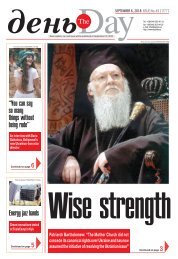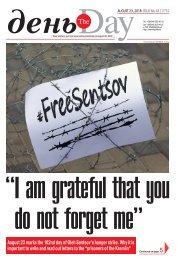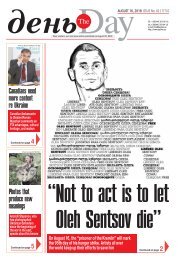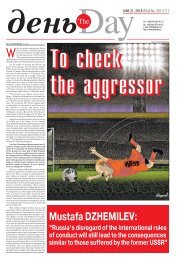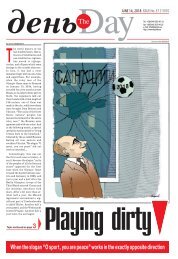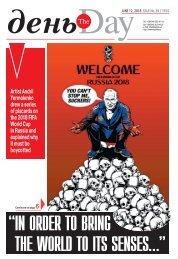You also want an ePaper? Increase the reach of your titles
YUMPU automatically turns print PDFs into web optimized ePapers that Google loves.
WWW.DAY.KIEV.UA<br />
CULT URE No.48 SEPTEMBER 27, 2018 7<br />
By Dmytro PLAKHTA, Lviv<br />
William Kurelek’s first and<br />
last name would have been<br />
Vasyl Kurylyk in Ukraine,<br />
the land of his forefathers,<br />
but he was born in Canada,<br />
where he was destined to become a<br />
distinguished Ukrainian-Canadian artist.<br />
His works are displayed in Canadian and<br />
US public art galleries and held in private<br />
collections, including those of Queen<br />
Elizabeth II and former Canadian prime<br />
ministers.<br />
He died at the age of 50, having constantly<br />
struggled with his mental illness,<br />
leaving behind 10,000 paintings and<br />
prints. There are 36 books written by him<br />
and about him in Canada, including<br />
400,000 copies of his A Prairie Boy’s Winter<br />
(1973) and A Prairie Boy’s Summer<br />
(1975), translated into 18 languages.<br />
He treasured his ethnic Ukrainian identity,<br />
although few people in Ukraine, apart<br />
from art critics, know about him. Fortunately,<br />
the first publication dedicated to his<br />
The Passion of Christ According to<br />
St. Matthew series (1975) appeared in<br />
print recently. Kurelek was the first artist<br />
to illustrate all of St. Matthew’s Gospel:<br />
160 works described by critics as masterpieces<br />
of religious art. In his last will and<br />
testament he wrote that he wanted The Passion<br />
of Christ to become known in Ukraine.<br />
Khrystyna BEREHOVSKA, the author<br />
of the art catalogue, is studying the<br />
Kurelek Phenomenon in world art, the topic<br />
of her doctorate at the Lviv National<br />
Academy of Art. She is determined to<br />
compile at least part of his creative legacy<br />
and promote it in Ukraine.<br />
Ms. Berehovska kindly agreed to an interview.<br />
We spoke about Kurelek’s eventful<br />
life and decided to focus on the educational<br />
aspect of his legacy, as well as on<br />
what related to his Ukrainian parentage,<br />
so the following is her story.<br />
● PEDAGOGICAL LOGIC<br />
BASED ON ART<br />
William Kurelek was born near Whitford,<br />
Alberta, in 1927. He spent his youth<br />
in Manitoba. His father came from Bukovyna<br />
in western Ukraine. His mother’s family<br />
was among the first Ukrainian immigrants<br />
in Canada. His relationship with his<br />
father left much to be desired, as his father<br />
refused to understand his elder son’s creative<br />
inclinations. The artist wrote later<br />
that his father treated him ruthlessly and<br />
would chase him out of the house in winter,<br />
leaving him without a coat and hat<br />
when the temperature was down to 30 o C;<br />
that he would often tell him that his<br />
younger brother was much smarter. This<br />
inevitably led to various complexes and<br />
phobias. Kurelek later said he was a fatherless<br />
son, even though he had a father.<br />
This would determine his main creative<br />
trend: the contrast between hatred and<br />
love, God and atheism, complete with angels<br />
and monsters. Parents and children<br />
were a frequent theme of his works. Pedagogical<br />
logic is based on his creative legacy<br />
and it is quite popular in Canada.<br />
Children often figure in his works. He<br />
had a difficult childhood and that was his<br />
way of making up for it, by portraying children,<br />
focusing on their inner world rather<br />
than their image. He was a loner from<br />
childhood and eventually became an introvert.<br />
His peers considered him peculiar,<br />
primarily because of the language he used.<br />
He spoke only Ukrainian until seven years<br />
of age. During his childhood, the future<br />
artist was both amused and depressed by<br />
his environment. For him, that environment<br />
was packed with contrasts. After he<br />
made his name as an artist, he decided to<br />
relive that experience in his works, depicting<br />
children of that time – so that his<br />
posterity would know as much about the<br />
way all those immigrant kids grew up in the<br />
Canadian prairies, what they looked like,<br />
how they spoke, as they would about the<br />
Inuits. He vividly displayed that Irish<br />
kids were different from their French<br />
peers, and that all this was part of Canadian<br />
multiculturalism.<br />
He was probably the only Canadian<br />
artist to illustrate this multiculturalism<br />
and his pioneer series won him the reputation<br />
of Manitoba-born Brueghel, Canadian<br />
Bosch, or Prairie van Gogh. He loved<br />
the way Breughel portrayed many people<br />
in one place and there are many children<br />
captured in motion in his pictures. They<br />
aren’t static, they are dynamic, full of life,<br />
and they look intelligent – something the<br />
artist always emphasized.<br />
● KURELEK, AN EXAMPLE<br />
According to Ms. Oksana Wynnyckyj-<br />
Yusypovych, Canadian Consul in Lviv,<br />
William Kurelek was an example her generation<br />
wanted to emulate, and that many<br />
children are of the same opinion. She specified<br />
that she was referring to Ukrainian-<br />
Canadian children who attended Ukrainian<br />
language schools; William Kurelek painted<br />
pictures and added captions explaining<br />
what a given picture was all about. He<br />
would paint children in the Canadian<br />
prairies and explain that they had to go to<br />
school and do household chores, including<br />
THE UKRAINIAN PIONEERS (1972), PART OF THE MURALS; MIXED MEDIA<br />
(152.5x729 CM; 152.5x121.5 CM), NATIONAL GALLERY OF CANADA (PHOTO<br />
TAKEN BY KHRYSTYNA BEREHOVSKA ON THE PREMISES OF THE GOVERNOR-<br />
GENERAL OF CANADA IN OTTAWA)<br />
The Ukrainian-Canadian Brueghel<br />
Art critic Khrystyna BEREHOVSKA says William<br />
Kurelek lived each day in a different world<br />
WILLIAM KURELEK, OCTOBER 1961 (PHOTO COURTESY OF THE KURELEKS’<br />
PRIVATE ARCHIVES)<br />
collecting hay, herding cows, and so on.<br />
Most children, born in today’s big cities<br />
with their high-rise condominiums and<br />
skyscrapers, don’t have the slightest idea<br />
about how to milk a cow or the difference<br />
between a goose and a hen, but they can see<br />
it in Kurelek’s pictures. He canonized the<br />
immigrant’s daily manual labor and his rural<br />
way of life. Mother and child were, of<br />
course, uppermost on his mind. He painted<br />
series of pictures, not just portraits, like<br />
the ones with a mother and daughter cooking<br />
jam, with a woman using her ax, chopping<br />
firewood, and her daughter collecting<br />
the logs, or with her teaching her daughter<br />
to make the sign of the cross in front of<br />
an icon. He placed special emphasis on team<br />
work and education. There is a picture in<br />
which a child is about to get into a basin<br />
with hot water and his mother is pointing<br />
a forbidding finger. He painted a lot of such<br />
pictures and they can be used as teaching<br />
aids for children, showing the way they<br />
should behave at home.<br />
● GUIDED BY GOD<br />
Almost each picture he created was a<br />
quest. He would come up with five outwardly<br />
identical pictures for children, but<br />
warn that there were 10 differences between<br />
them that had to be found. Such pictures<br />
currently sell at 50 to 300 Canadian<br />
dollars. He believed that every child should<br />
be encouraged to start learning high culture<br />
from the earliest possible age. In<br />
fact, this education system, based on intellectual<br />
and professional skills, is still being<br />
practiced in Canada.<br />
William Kurelek flew to Brussels to see<br />
how Breughel depicted children. He also<br />
visited Amsterdam to see Vincent van<br />
Gogh’s works. And then he made a trip to<br />
India to study the contrast between the rich<br />
and the poor. He always took a special interest<br />
in the poor, even after he became a<br />
man of considerable means. While in India,<br />
he donated to various orphans’ funds. He<br />
would visit again to make sure his money<br />
had made their life easier.<br />
His art is still serving to educate children,<br />
although he never cared about his<br />
own children’s education, but he often<br />
portrayed them in his works. His 10-yearold<br />
daughter is depicted as an adult angel<br />
standing with other angels by the Holy Sepulcher<br />
in his picture The Passion of Christ.<br />
For him, it was more than a painting. He<br />
adored children and saw them as cherubs<br />
and seraphs. Interestingly, he never referred<br />
to himself as a typical artist. He said<br />
he was a craftsman. Why? Because, he said,<br />
he had only the tools to make what God<br />
wanted him to make. He was, actually, a<br />
true believer and his Faith was probably the<br />
most important part of his life.<br />
● DIFFICULTIES OVERCOME<br />
THROUGH ART<br />
With all his creative accomplishments,<br />
a story about William Kurelek would be incomplete<br />
without mentioning his major affliction,<br />
I mean his mental disorder [although<br />
he died of cancer in the end –<br />
Ed.]. School bullying caused him to become<br />
an introvert. This and frequent family conflicts<br />
resulted in long periods of deep depression<br />
with which he would struggle for<br />
the rest of his life (few if any prefer to comment<br />
on this part of his biography). He<br />
started drawing and painting at an early<br />
age. Later, he received professional collegelevel<br />
training in Canada and Mexico… He<br />
coped with his physical/mental problems<br />
by painting – his doctors at the Maudsley<br />
Psychiatric Hospital in London thought it<br />
was the best treatment and he believed<br />
them. He was provided with paints, brushes,<br />
easels, the works. The result was spectacularly<br />
positive. Bethlem Royal Hospital<br />
has a museum where Kurelek’s pictures<br />
and sketches occupy a place of honor.<br />
Mental disorder had a tangible impact<br />
on his creativity. William Kurelek sustained<br />
a total of 14 electroshock therapies.<br />
I spoke to a psychiatrist and was told that<br />
the patient would never be his old self after<br />
this therapy. William Kurelek would<br />
meet the next day in a different world (in<br />
his mind). Interestingly, all photos show<br />
him as a cheerful, smiling individual. His<br />
relatives and other people who knew him<br />
insist that he was always sad. This complicated<br />
my task of putting the pieces of the<br />
puzzle of his personality in place. In fact,<br />
all who knew him told me different things<br />
about him. I had the impression that I was<br />
dealing with a split personality.<br />
● TRUE TO UKRAINIAN<br />
DESCENT<br />
As an adult, William Kurelek would always<br />
emphasize his Ukrainian parentage.<br />
Among his works is the mural The Ukrainian<br />
Pioneer, currently on display on the<br />
premises of the Governor-General of Canada.<br />
Ukrainian themes are traditionally<br />
present in his works, including the images<br />
of Taras Shevchenko, Ivan Franko, and<br />
Lesia Ukrainka that are found in his big<br />
multifunctional pictures. William Kurelek<br />
was always aware of his ethnic Ukrainian<br />
origin, although he couldn’t speak fluent<br />
Ukrainian and didn’t know Ukrainian<br />
grammar. His heart was with Ukraine. He<br />
was bullied in school because he spoke a language<br />
no one understood. He spoke Ukrainian<br />
to those who spoke English, but the bullying<br />
had its effect and he would find it<br />
hard to speak Ukrainian later. In fact, he<br />
hardly ever tried. But then, in 1970, he<br />
first flew to Soviet Ukraine to visit his father’s<br />
home village of Borivtsi in Chernivtsi<br />
oblast. His second cousin told me that<br />
he remained silent during the first day. The<br />
following day he went to the kitchen garden<br />
behind the house and started talking<br />
to himself in Ukrainian. Imagine the reaction<br />
of his relatives who happened to witness<br />
the scene. They all knew that he<br />
couldn’t speak Ukrainian. Another interesting<br />
detail. When I visited Borivtsi with<br />
his sister Nancy, she found herself lapsing<br />
into accented, stilted Ukrainian. She still<br />
remembered words and phrases she’d<br />
learned from her mother.<br />
William Kurelek always kept in touch<br />
with his relatives in faraway Ukraine. He<br />
would visit a local Ukrainian school and ask<br />
a teacher to translate into Ukrainian and<br />
write what he wanted to tell them. He never<br />
forgot about Ukraine, looking for the<br />
English versions of Ukrainian books, especially<br />
Taras Shevchenko and Ivan<br />
Franko. There were few sources at the time.<br />
● WILLIAM KURELEK MUST BE<br />
KNOWN IN UKRAINE<br />
He visited the land of his forefathers<br />
twice, leaving several of his works whose<br />
value remains to be determined by experts.<br />
Canada is jealously guarding his creative<br />
legacy, stressing that he was a Canadian<br />
artist. The sad fact remains that few<br />
in Ukraine know about this gifted personality.<br />
The good news is that I’m not the<br />
only one who is dealing with his Ukrainian<br />
origin. There are Christine Curkowskyj in<br />
Canada and Roman Yatsiv. It is very important<br />
that William Kurelek’s legacy be<br />
promoted in Ukraine. He is an artist of international<br />
acclaim and deserves every<br />
credit in the land of his forefathers. In<br />
1961, after his first exhibit, he said something<br />
he would write in Someone With Me:<br />
An Autobiography (1980), that in Canada<br />
his creativity was first discovered by Jewish<br />
women and then by the entire ethnic<br />
Jewish community; that it would be later<br />
appreciated by the ethnic French, Anglo-<br />
Saxon, and, lastly, by the ethnic Ukrainian<br />
community.<br />
How to promote William Kurelek in<br />
Ukraine? Organizing his art exhibits across<br />
Ukraine seems the best way – and my<br />
cherished dream is to see his Passion of<br />
Christ on display. Of course, I realize that<br />
this is easier said than done, that it is wishful<br />
thinking, most likely. New Ukrainian<br />
history textbooks are being written and I’m<br />
sure that each should have a chapter dedicated<br />
to the Ukrainian Diaspora boasting<br />
names like Alexander Archipenko, Jacques<br />
Hnizdovsky, and William Kurelek.<br />
LATE SUMMER, CENTRE ISLAND (1972), KHRYSTYNA BEREHOVSKA’S PHOTO<br />
OF PART OF THE PICTURE IN A PRIVATE COLLECTION, MIXED MEDIA<br />
(120x60 CM)





